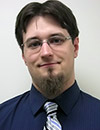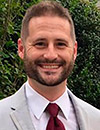1:00 PM
Opening remarks
 |
|
Hyperspectral imaging is a sensing modality which goes beyond discrete spectral measurements and builds a "data prism" comprised of spatial and spectral components. This talk will cover several applications of infrared hyperspectral imaging including material sorting, land mapping, and biomedical imaging. This talk will also discuss sensor materials applicable to infrared hyperspectral imaging and discuss pros and cons of them.
Paul Mark received his bachelor's in science from the University of Vermont in physics studying co-polymer structures using x-ray diffraction and his Ph.D. from Rutgers University studying nanophononics and the assembly of gold nanoparticles. He has worked on laser amplifiers, non-linear and crystalline optics, photolithography and optical metrology, and is now the Director of Marketing at Teledyne Judson, supporting their infrared products across the spectrum.
1:20 PM
Hyperspectral rare-target detection using dynamically generated synthetic data and deep neural networks
 |
|
Advanced Deep Learning methodologies have experienced significant accomplishments within the realm of Computer Vision, primarily due to the availability of extensive labeled datasets for training purposes. However, this has posed challenges for hyperspectral target identification applications, as there is a limited supply of labeled hyperspectral data, particularly for detecting rare target occurrences such as Chemical, Biological, Radioactive, Nuclear and Explosive (CBRNE) material. In this technical demonstration, we show how Metaspectral’s Fusion software can be used to create a rare-target detector using reference spectral signatures collected in a controlled lab setting. We show that synthetically generated spectral signatures can be used to train a Deep Learning neural network to achieve a level of accuracy that surpasses traditional statistical detection methods such as Adaptive Cosine Estimation (ACE). The assessment is carried out using airborne Short-Wave Infrared (SWIR) hyperspectral images, and target spectral signatures collected in a lab setting.
Migel Tissera co-founded Metaspectral with a mission to solve the world's most complex problems with next generation sensing. Their technology is currently applied in advanced recycling, aerospace and defense markets for AI based analysis of electro-optical data. He has had public conversations with Forbes, The Globe and Mail, TechCrunch, CBC, and NVIDIA AI Podcast. Previously, Migel worked for XPED Limited as the Head of Machine Learning and received his PhD at the University of South Australia in Deep Learning.
1:35 PM
Computational imaging in defense electro optical systems
 |
|
The development of mobile multi-core processors has created advances in computational photography that enable today’s mobile phones to take extraordinary images and video. These same processors are available to large sensor companies in adjacent markets including robotics and automotive autonomy. The ability to run the heavy compute demands of these algorithms on the edge at power levels under 5 watts is going to transform how electro optical systems can meet the needs of users in defense and commercial applications. Teledyne FLIR has developed Atlas, the industry’s first thermal ISP that delivers image processing capabilities designed to leverage the latest mobile SOCs performance. In addition, Teledyne FLIR has developed Prism AI, a framework for application specific object detection running on powerful and efficient neural networks.
Arthur Stout is the director of AI software product management for Teledyne FLIR’s OEM division in Goleta, CA. He has held a variety of business development, corporate strategy and product management roles since beginning his career in infrared sensing in 1986. The new digital products portfolio is the next step in Teledyne FLIR OEMs vertical integration strategy that is focused on delivering highly engineered imaging solutions for defense and commercial customers.
1:50 PM
Earth observation with optical filters
 |
|
Earth Observation (EO) has grown rapidly due to the commercialization of space and desire to be able to better measure and manage our environment. Multi-spectral imaging enables EO systems to observe and analyze simultaneously different terrestrial phenomenon of interest associated with specific wavelength bands. Wavelength selective optical filters and filter arrays play a key role enabling these systems to see "more signal, with less background."
Jason Palidwar is product group manager - ASO and marketing manager for Iridian Spectral Technologies and has been with the company since 2006. His current focus is on the optical filters used in satellite communications and Earth observation. He has over 20 years of experience working with thin-film optical filters. He has also developed filter specifications, together with Iridian’s customers, to optimize commercial needs in applications such as telecom, Raman spectroscopy, fluorescence microscopy, 3D entertainment, and IR remote sensing. Jason has a Master of Science degree in physics from McMaster University.
2:05 PM
NASA SAGE SBIR structural, thermal, optical performance (STOP) analysis correlation to wavefront error testing
 |
|
In conjunction with the NASA LaRC SAGE IV Pathfinder team, Quartus has developed a small format near-diffraction limited telescope designed to package into a 6U CubeSat. The SAGE IV Pathfinder telescope utilizes analytical models and designs that can be leveraged to meet a broad range of scientific optical mission needs by creating a family of semi-custom small format space-borne optical systems. During the initial phases of a science mission, a systems engineering assessment can be performed to identify existing designs and analysis tools that can be leveraged to meet many key requirements. This would allow limited resources to then be focused on developing required new components, as opposed to designing the entire optical system from the bottom up. This accelerates technical readiness level (TRL) progression on semi-custom small format precision optical system, reducing instrument costs, and achieving economy of scale typically not available on one-off science payloads.
Alexander Halterman has a bachelor’s degree in mechanical engineering and a master’s degree in aerospace engineering from Cornell University. His expertise is systems engineering, opto-mechanical engineering, and program management for remote sensing and precision optical systems across a wide range of industries and environments. He has experience at many levels of the development process including research and development, qualification, and transition to manufacturing. Alex joined in 2014 and has supported projects in a variety of roles, including the development of instrument architectures, technical budgets, hardware design, and hands-on build, test, and verification of completed hardware builds. He has been responsible for leading development efforts for customers across various industries, including but not limited to: space based remote sensing instruments, airborne topographic and bathymetric lidar sensors, high energy laser development, automotive lidar sensor systems, and DNA sequencing microscopy.
2:20 PM
Solutions for NVIS-compatibility measurements for NVIS-compatible displays and lighting components
 |
|
Compatibility between night vision goggles or imaging systems, as well as crew and cockpit displays and lighting, is critical in ensuring the safety of military, security, and rescue teams. Out of specification displays can result in blinding effects, such as blooming, that can lead to disastrous impairment of visibility. Spectroradiometers and photometers used to test such performance must conform to rigorous sensitivity and dynamic range criteria, as well as meet or exceed MIL-STD-3009/ MIL-L-85762A Appendix B requirements, which few commercial instruments do.
Chris Gordon obtained his bachelor's degree in chemistry from Muhlenberg College in 2006. He attended the University of South Carolina where he earned his master's degree in analytical chemistry and spectroscopy in 2011. The focus of his research was developing chemical sensors using laser-induced breakdown and Raman spectroscopies. His contributing work on the use of a spatial heterodyne spectrometer in Raman spectroscopy was awarded the Fred M. Megger’s award for outstanding publication in Applied Spectroscopy in 2011. After graduate school he taught chemistry at the high school and collegiate level until 2019 when he joined Optronic Laboratories, LLC. as a product scientist.
2:35 PM
Closing remarks
